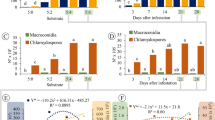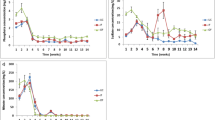Abstract
Isolates of Alternaria alternata, Botrytis cinerea, Fusarium oxysporum, Penicillium sp., Rhizoctonia solani, Stemphylium sp., Thielaviopsis basicola, and Verticillium dahliae were cultured on potato–dextrose agar (PDA), barley-sand and alfalfa-sand substrates in petri-dish or in column microcosms. N-mineralization by fungi and fungal-feeding nematodes in combination or fungi alone was assessed. Numbers of Aphelenchus avenae or Aphelenchoides composticola supported by the fungi were measured every 7 days. Times for full colonization of the substrates by fungi ranged from 5 to 15 days. Rhizoctonia solani and B. cinerea on PDA supported the largest A. avenae and A. composticola populations, respectively. Penicillium sp. was a nonhost for A. composticola and A. avenae. Rhizoctonia solani, B. cinerea, V. dahliae, and F. oxysporum supported significantly more nematodes than the other four fungal species. The ranked order of fungi based on the amount of N mineralized in columns free of nematodes was A. alternata (with a rate of 0.052 μg N/g-sand per day), Stemphylium sp., V. dahliae, T. basicola, B. cinerea, F. oxysporum, R. solani, and Penicillium sp. (with a rate of 0.0045 μg N/g-sand perday). The presence of A. avenae resulted in significant increases in mineral N, compared to nematode-free columns colonized by F. oxysporum, R. solani, and T. basicola alone. The presence of A. composticola resulted in significant increases in mineral N, compared to nematode-free columns colonized by A. alternata, B. cinerea, F. oxysporum, and R. solani alone. There was more mineral N incolumns in the presence of A. composticola than A. avenae in most cases.
Similar content being viewed by others
References
Agrios G N 1978 Plant Pathology. Academic Press, New York. 703 p.
Anderson R V, Coleman D C and Cole C V 1981 Effects of saprotrophic grazing on net mineralization. Ecol. Bull. 33, 201–216.
Binkley D, Suarez F, Stottlemyer R and Caldwell B 1997 Ecosystem development on terraces along the Kugururok River, northwest Alaska. Ecoscience 4, 311–318.
Carlson R M 1978 Automated separation and conductimetric determination of ammonia and dissolved carbon dioxide. Anal. Chem. 50, 1528–1531.
Chen J and Abawi G S 1996 A simple method for obtaining large quantities of second-stage juveniles of root-knot nematodes. Phytopathology 86, S98.
Chen J and Ferris H 1997 Nitrogen mineralization by Aphelenchus avenae associated with Rhizoctonia sp. and barley straw. J. Nematol. 29, 572.
Chen J and Ferris H 1999 The effects of nematode grazing on nitrogen mineralization during fungal decomposition of organic matter. Soil Bio. Biochem. 31, 1265–1279.
Dighton J 1995 Nutrient cycling in different terrestrial ecosystems in relation to fungi. Can. J. Bot. 73, 1349–1360.
Dighton J and Boddy L 1989 Role of fungi in nitrogen, phosphorus and sulphur cycling in temperate forest ecosystems. In Nitrogen, Phosphorus and Sulphur Utilization by Fungi. Eds Lynne Boddy, R Marchant and D J Read. pp 268–298. Cambridge University Press, New York.
Dix N J and Webster J 1995 Fungal Ecology. Chapman & Hall, New York. 549 p.
Ferris H, Venette R C, van der Meulen H R and Lau S S 1998 Nitrogen mineralization by bacterial-feeding nematodes: verification and measurement. Plant Soil 203, 159–171.
Foster J W 1949 Chemical Activities of Fungi. Academic Press. New York. 648 p.
Giannakis N and Sanders F E 1989 Interactions between mycophagous nematodes, mycorrhizal and other soil fungi. Agric. Ecosyst. Environ. 29, 163–167.
Griffin D M 1972 Ecology of Soil Fungi. Chapman and Hall, London. 193 p.
Griffiths R P, Entry J A, Ingham E R and Emmingham W H 1997 Chemistry and microbial activity of forest and pasture riparianzone soils along three Pacific Northwest streams. Plant Soil 190, 169–178.
Gupta M C 1986 Biological control of Fusarium moniliforme Sheldon and Pythium butleri Subramaniam by Aphelenchus avenae Bastian in chitin and cellulose-amended soils. Soil Bio. Biochem. 18, 327–329.
Hawksworth D L and Mound L A 1991 Biodiversity databases: The crucial significance of collections. In The Biodiversity of Microorganisms and Invertebrates: Its Role in Sustainable Agriculture. Ed. D L Hawksworth. pp 17–29. C.A.B International, Wallingford, Oxon, UK. 302 p.
Hendrix P F, Parmelee R W, Crossley D A Jr, Coleman D C, Odum E P and Groffman P M 1986 Detritus food webs in conventional and no-tillage agroecosystems. Bioscience 36, 374–380
Hesling J J 1977 Aphelenchoides composticola. In C.I.H. Descriptions of Plant-Parasitic Nematodes. Eds S Willmott, P S Gooch, M R Siddiqi and M T Franklin. Set 7, No. 92. Commonwealth Agricultural Bureaux, Farnham Royal, Slough, UK.
Hooper D J 1974Aphelenchus avenae. In C.I.H. Descriptions of Plant-Parasitic Nematodes. Eds S Willmott, P S Gooch, M R Siddiqi and M T Franklin. Set 4, No. 50. Commonwealth Agricultural Bureaux, Farnham Royal, Slough, UK.
Ingham R E, Trofymow J A, Ingham E R and Coleman D C 1985 Interactions of bacteria, fungi and their nematode grazers: effects on nutrient cycling and plant growth. Ecol. Monogr. 55, 119–140.
Ishibashi N and Choi D R 1991 Biological control of soil pests by mixed application of entomopathogenic and fungivorous nematodes. J. Nematol. 23, 175–181.
Jordan D, Kremer R J, Bergfield W A, Kim K Y and Cacnio V N 1995 Evaluation of microbial methods as potential indicators of soil quality in historical agricultural fields. Biol. Fertil. Soils. 19, 297–302.
Klink J W and Barker K R 1968 Effect of Aphelenchus avenae on the survival and pathogenic activity of root-rotting fungi. Phytopathology 58, 228–232.
Lee D L and Atkinson H J 1977 Physiology of Nematodes. Columbia University Press, New York.
Mankau S K and Mankau R 1962 Multiplication of Aphelenchus avenae on phytopathogenic soil fungi. Phytopathology 52, 741.
Mankau R and Mankau S K 1963 The role of mycophagous nematodes in the soil. I. The relationships of Aphelenchus avenae to phytopathogenic soil fungi. In Soil Organisms. Eds J Doeksen and J van der Drift. pp 271–280. North Holland, Amsterdam, The Netherlands.
Neter J, Wasserman W and Kutner M H 1990 Applied Linear Statistical Models: regression, analysis of variance, and experimental designs. Irwin, Homewood, IL. 1181 p.
Scarsbrook C E 1965 Nitrogen availability. In Soil Nitrogen, Agronomy Monograph 10. Eds W V Bartholomew and F E Clark. pp 481–502. Academic Press, New York.
Stanford G 1982 Assessment of soil nitrogen. In Nitrogen in Agricultural Soils. Ed. F J Stevenson. pp 651–688. American Society of Agronomy, Madison, WI.
Townshend J L 1964 Fungus host of Aphelenchus avenae Bastian, 1865 and Bursaphelenchus fungivorus Franklin & Hooper, 1962 and their attractiveness to these nematode species. Can. J.Microbiol. 10, 727–737.
Trofymow J A and Coleman D C 1982 The role of bacterivorous and fungivorous nematodes in cellulose and chitin decomposition. In Nematodes in Soil Ecosystem. Ed. D W Freckman. pp 117–138. University of Texas Press, Austin, TX.
Wright D J and Newall D R 1976 Nitrogen excretion, osmotic and ionic regulation in nematodes. In The Organization of Nematodes. Ed. N A Croll. pp. 163–210. Academic Press, New York.
Author information
Authors and Affiliations
Rights and permissions
About this article
Cite this article
Chen, J., Ferris, H. Growth and nitrogen mineralization of selected fungi and fungal-feeding nematodes on sand amended with organic matter. Plant and Soil 218, 91–101 (2000). https://doi.org/10.1023/A:1014914827776
Issue Date:
DOI: https://doi.org/10.1023/A:1014914827776




